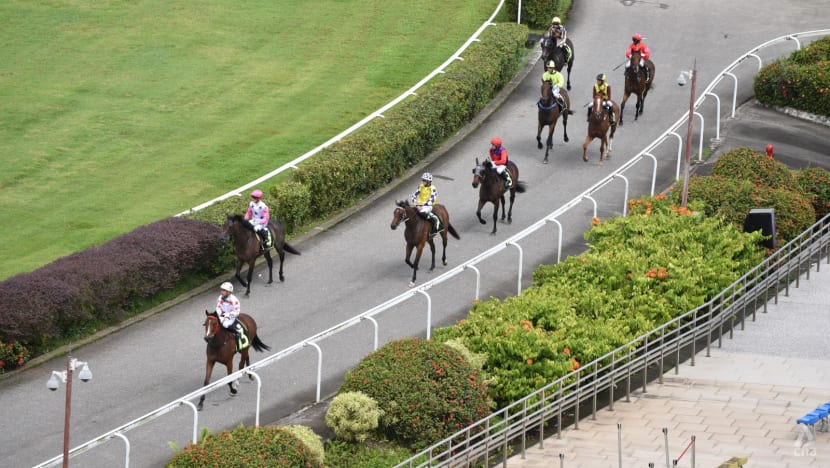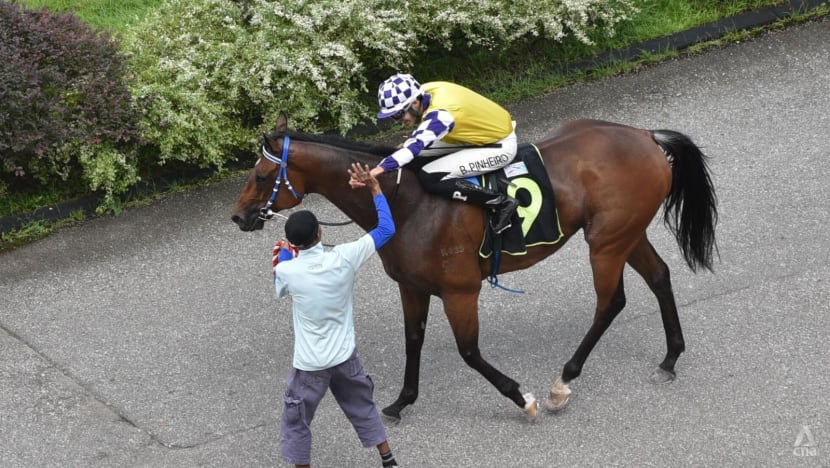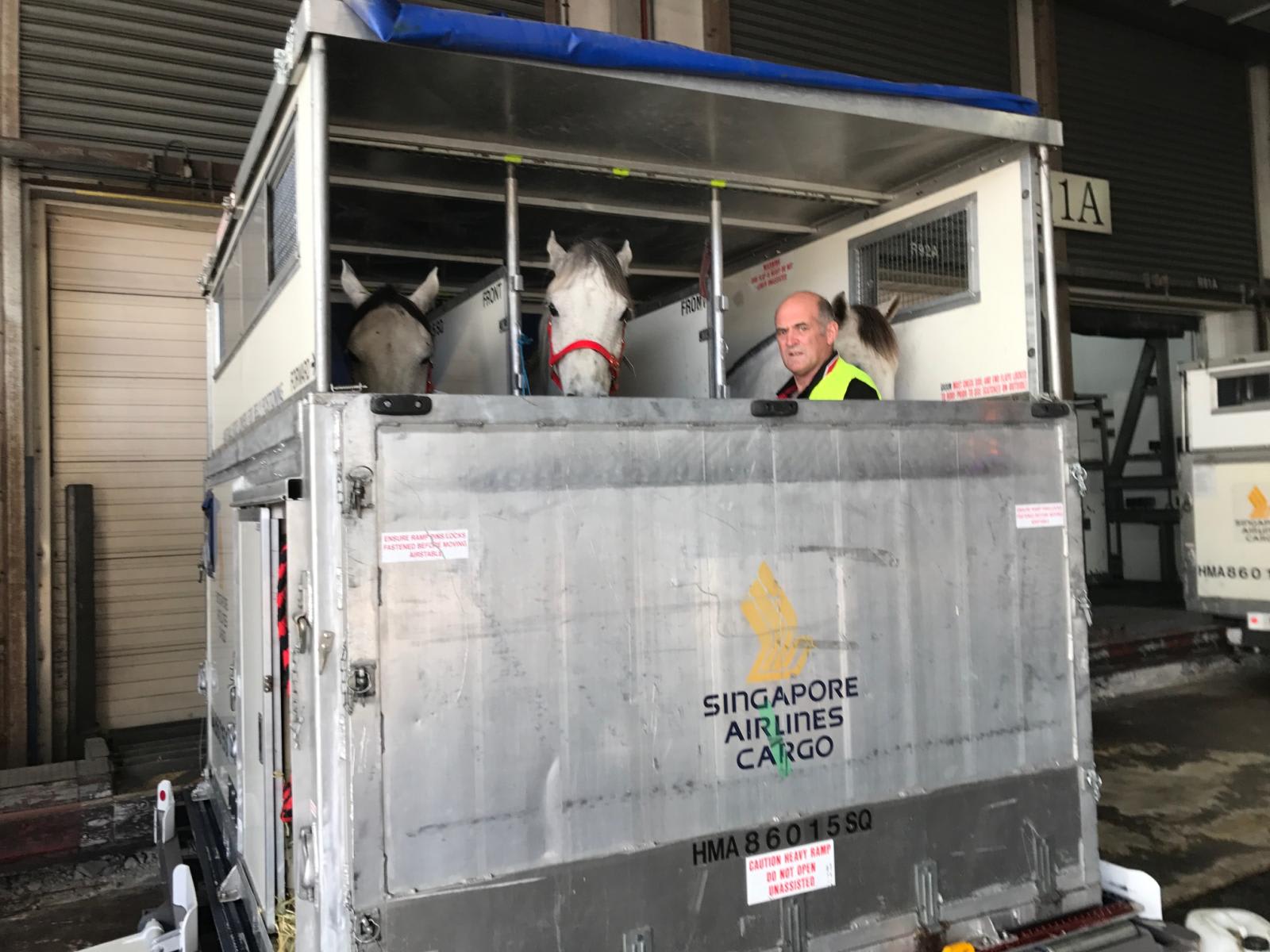CNA Explains: The challenges of relocating hundreds of horses from Singapore Turf Club
Quarantine, vaccinations and transport costs are just some of the numerous considerations in relocating a horse.

Jockeys and their horses making their way to the cooling area to dismount after a race at the Singapore Turf Club on Jun 11, 2023. (Photo: CNA/Jeremy Long)
SINGAPORE: Finding a new home abroad for hundreds of horses - when racing at the Singapore Turf Club comes to a close in late 2024 - will be challenging, according to industry players.
On Tuesday (Jun 13), the Asian Racing Federation expressed concern that rehoming about 700 horses from Singapore - whether to other turf clubs to continue racing, or to farms or stables for retirement - will be a “massive task”.
“(This) brings with it horse welfare considerations which will require extensive planning,” the federation said in a press release. It anticipates “extraordinary demands being placed on limited quarantine facilities and operations” among its clubs.
On Wednesday, a group of horse owners said they would appeal to the government for horse racing to continue in Singapore.
Should the government stick to its decision, many of the horses are likely to be moved after the last race in Singapore on Oct 5, 2024 - though some owners have said that they want to exit before that.
CNA explores the logistics behind exporting horses from Singapore.
WHERE WILL MOST OF THE HORSES GO?
Currently, many of those exported from Singapore end up in Malaysia.
New Zealand's International Racehorse Transport firm said exports from Singapore have traditionally been to Malaysia, on a monthly basis.
“Horses to Malaysia are usually horses that have not performed to a level that meets Singapore requirements,” said director Lachlan Ford. "Or (it's a case of) owners deciding to better place their horses on the Malaysia racing circuit."
Horse trainers told CNA about 40 of the animals go to Malaysia every month. The horses also have to meet certain requirements to race there.
For instance, all racehorses are assigned points based on a handicap rating system, Mr Jason Lim explained. If the horse scores less than 25 points, and is above seven years old, it cannot be exported to Malaysia.

Malaysian operators have also weighed in on the situation, with Penang Turf Club’s general manager and secretary Leow Khin Ming telling CNA it is “still too early” to know the impact on them when horse racing in Singapore ends.
But Selangor Turf Club in Kuala Lumpur has said it is ready to build stables to take in horses from Singapore. The club has 880 stable boxes with about 85 per cent occupancy, and has the capacity to build another 200 if there is demand.
WHAT ABOUT OTHER COUNTRIES?
Mr Lim, the trainer, said there was “an assumption” that all horses will go to Malaysia because it’s the “easiest way out”. But some could head to places like Dubai, Macau and Australia.
Either way, relocating a horse comes with a hefty price tag. The animals need to undergo quarantine, vaccinations and export certification, on top of the transport expenses.
CNA was previously told that it could cost about S$5,000 to send a horse to Malaysia, S$9,000 to Thailand and S$20,000 to Australia.
Airfreight companies that handle horse transport said Singapore rarely exports to countries like Australia or New Zealand, beyond a few shipments a year.

The few shipped to Australia might be retiring horses, fillies - young females - that will be bred or equestrian (horse-riding) mounts whose owners are relocating. To bring a horse to race in Australia, it would have to be highly competitive, said Equine International Airfreight’s director Cameron Croucher.
“The standard of horse racing in Australia is very high. People aren't going to spend the money to send a horse from Singapore (to) Australia ... and not be competitive,” he said.
Mr Croucher estimates that only about 50 horses have been exported from Singapore to Australia in the last five years.
However, since the announcement of Singapore Turf Club's closure, he has had queries to export about 50 to 60 horses to Australia, New Zealand, Macau, Thailand and the Philippines.
Exporting to each country has different challenges due to different rules and procedures, said Mr Croucher, giving the example of Singapore's limited capacity for quarantining horses for exportation.
WHAT ARE THE QUARANTINE ISSUES?
International Racehorse Transport's Mr Ford described quarantine requirements as one of his greatest concerns. For example, Australia has very strict biosecurity measures for horses being imported.
Singapore has a facility approved by the Australian Department of Agriculture, which caters for eight horses at a time to quarantine for two weeks before being moved to Australia. This intake happens approximately once a month, under current arrangements.
Upon arrival in Australia, horses are then required to do a two-week quarantine.
This means it would take 25 months to clear 200 horses being sent to Australia, if quarantine capacity is not expanded.
And it also means that thinking of just exporting 700 horses once racing in Singapore ends in October 2024 "is not feasible under the current infrastructure", said Mr Ford.
Equine International Airfreight’s director Mr Croucher added that while current quarantine capacity for exportation is a bottleneck, Singapore has a much larger capacity for quarantining horses coming into Singapore – which could potentially be converted.
But he does not expect that to happen soon, as he believes the Singapore Turf Club will “want to retain as many horses in Singapore as they can until October 2024”.
WHAT ELSE GOES INTO REHOMING THE HORSES?
Industry players also expressed concern for the horses' care during the long process of exportation.
They are “very fragile animals”, said Mr Lim, the trainer. "If there’s no proper placement of them or proper people to take care of them, there will be a very big animal welfare issue.”
The Singapore Turf Club has said it will provide subsidies for the care of the horses at S$700 a month, on top of export subsidies.
Added Mr Ford: “Horses are not like general freight, you can’t just flick a switch and say time to move, there is a lot of planning required.”
Listen: What does reskilling mean in a niche industry?
Once in another country, horses need to be retrained before returning to a racing environment, said Mr Ford.
After completing quarantine requirements in Australia or New Zealand, the horses would effectively be “out of work” for five to six weeks, and the retraining process could take approximately another 10 to 14 weeks, once they arrive at their final destination.
And should the horse be exported with a preexisting injury, rehabilitation will take extra time depending on the extent of its injury.
Racehorses are athletes and not ordinary horses in a paddock, so looking for a suitable place for them has to come before the export process, added Mr Croucher.
“To be at the top of their game, there's a lot of work that goes into them, and finding the best avenue for their exit from Singapore is a tricky one.”
CAN'T THE HORSES STAY IN SINGAPORE?
Asked if stables in Singapore could take in the horses, Mr Jason Lim and fellow trainer Richard Lim pointed to space constraints.
“Whether they can take in our retired horses, they may (be able to). But whether they want or not, that’s another issue,” said Mr Richard Lim.
Then there are horses aged three or four that are too young to retire and “very fit”, said Mr Jason Lim, adding that they would "still want to race on”.
Local stables that spoke to CNA shared that they couldn't accommodate more horses at this time. But some said it was possible for off-the-track thoroughbreds - trained to race but no longer actively doing so - to be retrained for a “second career” in riding schools.
“Well, horses come and go. Sometimes horses are retired, sometimes they’re exported. But in a couple of years' time, I can’t really tell you what’s going to be happening," said Ms Monique Heah, secretary-general of the Equestrian Federation of Singapore.
"We can take a couple more, but not like 700.”
The National Equestrian Centre – the riding school housed under the federation – is currently “running at about full capacity”, she said.
The Singapore Polo Club’s honorary secretary, Mr Rickard Hogberg, also told CNA that the club has no space for more horses at the moment.
Ms Heah said the National Equestrian Centre has two employees who could teach trainers how to retrain racehorses to become dressage horses, show jumpers or even endurance riding horses.
Dressage is a sport where a rider gets a horse to execute precise movements.
“Racehorses … what they have to do is very different from the equestrian sport. So we settle them down. It takes a while … anywhere from three to six months to settle a horse into a different profession,” said Ms Heah.
“We don’t do the galloping so much; we bring them down to dressage first ... And when we find that some are quite talented in jumping, they go into that.
“There’s some sort of process that is required to bring them down from racing to sport riding.”
















.jpg?itok=2qqlf3Rk)





